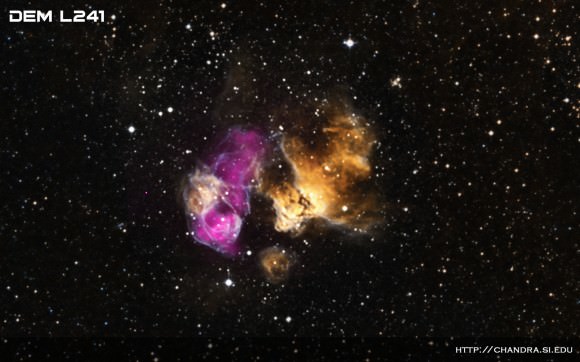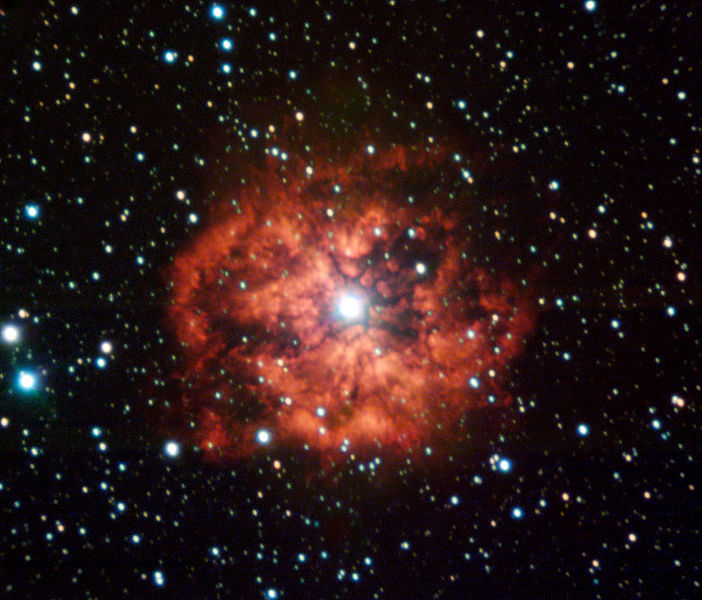Wolf-Rayet stars represent a final burst of activity before a huge star begins to die. These stars, which are at least 20 times more massive than the Sun, “live fast and die hard”, according to NASA.
Their endstate is more famous; it’s when they explode as supernova and seed the universe with cosmic elements that they get the most attention. But looking at how the star gets to that explosive stage is also important.
When you look at a star like the Sun, what you are seeing is a delicate equilibrium of the star’s gravity pulling stuff in, and nuclear fusion inside pushing pressure out. When the forces are about equal, you get a stable mass of fusing elements. For planets like ours lucky enough to live near a stable star, this period can go on for billions upon billions of years.
Being near a massive star is like playing with fire, however. They grow up quickly and thus die earlier in their lives than the Sun. And in the case of a Wolf-Rayet star, it’s run out of lighter elements to fuse inside its core. The Sun is happily churning hydrogen into helium, but Wolf-Rayets are ploughing through elements such as oxygen to try to keep equilibrium.

Because these elements have more atoms per unit, this creates more energy — specifically, heat and radiation, NASA says. The star begins to blow out winds reaching 2.2 million to 5.4 million miles per hour (3.6 million to 9 million kilometers per hour). Over time, the winds strip away the outer layers of the Wolf-Rayet. This eliminates much of its mass, while at the same time freeing its elements to be used elsewhere in the Universe.
Eventually, the star runs out of elements to fuse (the process can go no further than iron). When the fusion stops, the pressure inside the star ceases and there’s nothing to stop gravity from pushing in. Big stars explode as supernova. Bigger ones see their gravity warped so much that not even light can escape, creating a black hole.
We still have a lot to learn about stellar evolution, but a few studies over the years have provided insights. In 2004, for example, NASA issued reassuring news saying these stars don’t “die alone.” Most of them have a stellar companion, according to Hubble Space Telescope observations.

While at first glance this appears as just a simple observation, cosmologists said that it could help us figure out how these stars get so big and bright. For example: Maybe the bigger star (the one that turns into a Wolf-Rayet) feeds off its companion over time, gathering mass until it becomes stupendously big. With more fuel, the big stars burn out faster. Other things the smaller star could influence could be the bigger star’s rotation or orbit.
Here’s a few other facts about Wolf-Rayets, courtesy of astronomer David Darling:
- Their names come from two French astronomers, Charles Wolf and Georges Rayet, who discovered the first known star of this kind in 1867.
- Wolf-Rayets come in two flavours: WN (emission lines of helium and nitrogen) and WC (carbon, oxygen and hydrogen).
- Stars like our Sun evolve into more massive red giants as they run out of hydrogen to burn in the core. When these stars begin to shed their outer layers, they behave somewhat similarly to Wolf-Rayets. So they’re called “Wolf-Rayet type stars”, although they’re not exactly the same thing.
We have written many articles about stars here on Universe Today. Here’s an article about a binary pair of Wolf-Rayet stars, and the good news that WR 104 won’t kill us all. We have recorded several episodes of Astronomy Cast about stars. Here are two that you might find helpful: Episode 12: Where Do Baby Stars Come From, and Episode 13: Where Do Stars Go When they Die?


Nice article, but don’t you mean more luminous in the sentence below?
The Sun is not an accreting star or in a close binary system, as far as I know ….
“Stars like our Sun evolve into more massive red giants as they run out of hydrogen to burn in the core.”
“Because these elements have more atoms per unit”: than what? Per unit of what?
If you mean “than lighter elements”, “per unit of mass” then no, it’s the other way round, and it’s not directly related to energy output.
Fusion of heavier elements requires higher temperature and pressure than lighter elements because their nuclei must overcome their higher electric repulsion to fuse. The gravity/radiation pressure equilibrium is pushed toward higher pressure and density, also making fusion faster than during previous phases. This is (partly) why the star gets brighter; also each phase is of shorter duration than the previous ones.